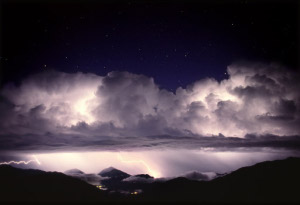 Credit: T. Credner & S. Kohle, AlltheSky.comYou may be surprised to hear that Venus is the warmest planet in the solar system. Venus has an average temperature of 850 degrees Fahrenheit. This is much warmer than the Earth, at 60 degrees, and even warmer than Mercury, which sits much closer to the sun, at 350 degrees. A reader asked if the high temperature on Venus was related to the composition of the atmosphere.
Credit: T. Credner & S. Kohle, AlltheSky.comYou may be surprised to hear that Venus is the warmest planet in the solar system. Venus has an average temperature of 850 degrees Fahrenheit. This is much warmer than the Earth, at 60 degrees, and even warmer than Mercury, which sits much closer to the sun, at 350 degrees. A reader asked if the high temperature on Venus was related to the composition of the atmosphere.
It turns out that the atmosphere of Venus is actually made almost entirely of carbon dioxide, and a lot of it. Because of this thick atmosphere and clouds of reflective sulfuric acid, not much was known about the planet's surface until recently. Before 1960, astronomers couldn't even estimate the length of one day on Venus! Now satellites, like the Venus Express, orbit around the planet and landers, like the Soviet Venera, have reached the surface.
We now know that the surface of Venus is scarred with impact craters, lava flows and more volcanoes than any other planet in the solar system. We know that the atmosphere is almost entirely carbon dioxide and that this atmosphere is responsible for severe global warming on the planet. However, we don't know if any of these volcanoes are still active, how much water was originally present, or if conditions were ever conducive to life.
Reading the stats on Venus got me thinking about the conditions on the other planets. Looking for the details, I came across a nice website dedicated to the solar system, www.nineplanets.org. Although each planet has a very complex composition, I list here only the one or two most common gases in each planet's atmosphere. Mercury: essentially no atmosphere; Venus: almost 100 times pressure at Earth's surface, mostly carbon dioxide, very hot; Earth: roughly 78% nitrogen and 21% oxygen, very little carbon dioxide; Mars: Very thin, atmospheric pressure 100 times less than Earth, mostly carbon dioxide; Jupiter: atmosphere indistinguishable from surface, 90% hydrogen and 10% helium; Saturn: 75% hydrogen, 25% helium; Uranus: 83% hydrogen, 15% helium; Neptune: mostly hydrogen and helium.
In reading over the description of the planetary atmospheres, you may notice some interesting trends. For one thing, the Earth definitely stands out with its atmosphere of nitrogen and oxygen. Maybe all of the life on Earth's surface is responsible? Maybe the water??
